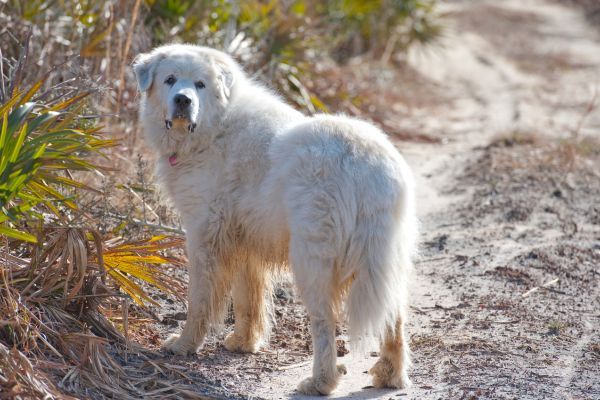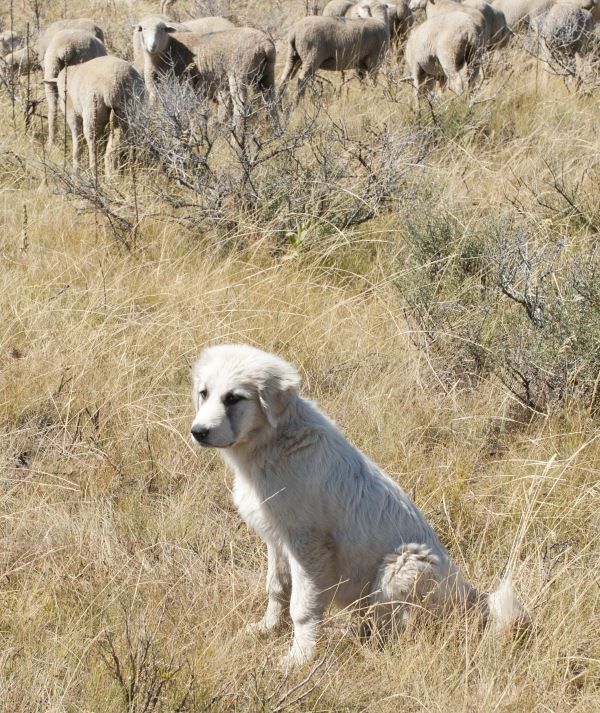Great Pyrenees


| Recommended for | Experienced owners in rural areas and large suburban homes |
| Breed Classification | Working group |
| Other names | Pyrenean Mountain Dog, Pyr, Le Chien des the Pyrenees |
| Lifespan | 10 to 12 years |
| Size | Large |
| Temperament | Affectionate, Fearless, Confident, Gentle, Patient, Strong Willed |
| Intelligence | Above average |
| Tendency to bark | High, especially in response to perceived threats |
| Maintenance Level | Moderate grooming needs, moderate food costs |
| Health Risk | High probability of health issues during its lifetime, hence it is one of the more expensive breeds to insure. |
Insuring a Great Pyrenees?
Get our award-winning Nose-to-Tail Cover with up to $30k annual benefit limit, up to 90% of eligible vet bills back, and no sub-limits.
Get a quick quote
Is this breed right for you?
Try our breed selector quiz to find out your best matching breed!
Insuring a Great Pyrenees?
Get our award-winning Nose-to-Tail Cover with up to $30k annual benefit limit, up to 90% of eligible vet bills back, and no sub-limits.
Get a quick quote
Breed history of Great Pyrenees
The Pyrenean Mountain Dog, also known as the Great Pyrenees, has a rich and ancient lineage dating back thousands of years to the Pyrenees Mountains, which form a natural border between France and Spain. This breed was raised by pastoral communities to protect livestock from predators like wolves and bears. Its origins trace back to ancient European dogs bred specifically for livestock protection, and the breed developed in isolation, retaining its core traits of strength, independence, and a composed, watchful nature.
The Great Pyrenees was shaped by the harsh environmental conditions of the mountains and the shepherding practices of the region. Unlike herding dogs, whose job is to manage the movement of livestock, the Great Pyrenees was a guardian, living among the herds it protected and always ready to defend. Its large size and calm temperament made it invaluable to shepherds, who relied on its loyalty and effectiveness in warding off predators.
By the 20th century, the breed saw a decline as its traditional role in guarding livestock lessened due to changes in agriculture. However, dedicated breeders worked hard to preserve the breed’s distinctive traits. Today, the Great Pyrenees is officially recognised by major kennel clubs such as the American Kennel Club (AKC), United Kennel Club (UKC), and The Kennel Club (UK). Though it may no longer be a common sight in its original role, the Great Pyrenees is now cherished as both a family protector and a loyal companion, known for its serene and protective nature.

Physical description of Great Pyrenees
The Great Pyrenees is a massive and majestic breed, built with a powerful, muscular physique, designed to protect livestock and thrive in rugged mountain environments. Their broad head, dark expressive eyes, and strong, straight muzzle create an overall impression of strength, balance, and calm vigilance.
A defining feature of the Great Pyrenees is its thick, weather-resistant double coat, primarily white with possible grey, tan, or reddish-brown markings. This luxurious coat not only helps them blend into their surroundings but also offers excellent protection against harsh weather. The long outer coat is straight and slightly rough, while the dense, woolly undercoat provides warmth during the colder months.
| Weight range | Male: 45 – 73 kg, Female: 39 – 52 kg |
| Height range | Height: Male: 70 – 80 cm, Female: 65 – 75 cm |
| Colours | Predominantly white, with variations in shades of gray, tan, reddish-brown, or badger markings |
| Coat length | Medium |

Great Pyrenees personality and temperament
Great Pyrenees dogs are known for their peaceful, kind, and protective nature. Originally bred to protect livestock, they exhibit bravery, independence, and a natural instinct to safeguard those in their care. While they are self-reliant, Great Pyrenees are also affectionate and loving towards their family members. Their ability to entertain themselves makes them well-suited for rural settings, but they still thrive on close relationships and enjoy being with their family and friends.
Loyal and devoted, the Great Pyrenees forms strong bonds with their family and flourishes when included in daily activities. They love spending time close to their loved ones, whether through play, training, or simply relaxing together. You’ll often find them following their owners around the house or yard, always keeping a watchful eye. This closeness is essential for their emotional well-being, as long periods of isolation can lead to anxiety or restlessness.
Bred to work alongside humans, the Great Pyrenees is highly attuned to the emotions of those around them. Their calm and composed demeanour makes them excellent therapy or support dogs, providing comfort and stability to those in need. Their empathetic nature allows them to offer emotional support, acting as a calming presence in stressful situations.
Adaptable to various living environments, the Great Pyrenees can thrive in both rural settings and larger suburban homes. Their innate protective instincts make them superb guardians, ensuring the safety of their loved ones and property with quiet confidence.

Great Pyrenees with kids and other pets
Great Pyrenees dogs are gentle and caring companions, making them a good fit for families with children. Their calm and loyal nature, combined with strong protective instincts, allows them to naturally take on a guardian role within the household. They patiently watch over children, often displaying a protective instinct to keep little ones safe. However, due to their large size, it’s important to supervise interactions to ensure safety and comfort for both the dog and the kids.
Great Pyrenees dogs generally get along well with other pets, especially when socialised from a young age. Their natural calmness and friendly disposition make them excellent companions for other animals. However, due to their strong protective tendencies and independent nature, early and consistent training is important to prevent dominance issues and to foster positive relationships with smaller pets. Monitoring interactions, particularly with smaller animals, is crucial to ensure peaceful and smooth relationships.

Great Pyrenees training and exercise
Great Pyrenees dogs require regular exercise and mental stimulation to stay healthy, happy, and well-balanced. Although they are generally calm and prefer quiet observation over highly energetic activities, they still benefit from daily walks and play sessions to keep them fit. Mental stimulation through puzzle toys, problem-solving games, and learning new skills is also important to prevent boredom and unwanted behaviours.
As an independent breed, the Great Pyrenees thrives when given consistent guidance and meaningful tasks. Early socialisation and training are essential to ensure positive interactions, especially given their size and natural guarding instincts. Using positive reinforcement in early training helps establish obedience and respect, setting clear roles and boundaries for the dog.
| Energy level | Moderate |
| Exercise requirements | Moderate |

Great Pyrenees feeding and nutrition
Good nutrition is essential for the health and energy of the Great Pyrenees. Due to their large size and high energy levels, they require a well-balanced diet rich in quality proteins, fats, and key nutrients to support muscle growth and maintain a healthy coat. Providing high-quality dog food tailored to their specific life stage, from puppyhood to adulthood, ensures their nutritional needs are met. Consulting with a vet is important when creating a feeding plan that offers the best nutrition as your Great Pyrenees matures.
The dietary needs of a Great Pyrenees change as they age. Puppies need protein-rich food to support their rapid growth and development, while adult dogs require a balanced diet to maintain energy levels without leading to excessive weight gain. As seniors age, they may benefit from lower-calorie food and supplements to support joint health and mobility.
Monitoring portion sizes, adjusting their diet based on age and activity level, and scheduling regular vet check-ups will help keep your Great Pyrenees healthy and well-nourished throughout their life.

Great Pyrenees care and grooming
The Great Pyrenees has a dense double coat that is weather-resistant and sheds moderately throughout the year, with heavier shedding during seasonal transitions. To keep their coat in good condition, regular grooming is essential for maintaining both their health and appearance. Brushing two to three times a week helps remove loose hair and prevent tangling, with extra attention needed during shedding seasons. This routine not only keeps the dog comfortable but also helps reduce the amount of hair around the house.
Bathing should be done as needed, but not too frequently, as excessive washing can strip the coat of its natural oils. Regular nail trimming, ear cleaning, and dental care are also key aspects of their grooming routine. While the Great Pyrenees doesn’t require much trimming, occasional trimming around the paws and ears helps keep them looking neat. Avoid shaving their coat, as it serves as natural protection against harsh weather conditions.
Health issues for Great Pyrenees
- Hip Dysplasia is a common health issue in Great Pyrenees, affecting the development of the hip joint and leading to joint instability and arthritis. This hereditary condition causes symptoms such as limping, discomfort, and difficulty with mobility. While genetics are the primary factor, rapid growth, excessive weight, and lack of proper exercise can worsen the condition, increasing the severity of symptoms.
- Elbow Dysplasia is another concern for some Great Pyrenees, causing abnormal development of the elbow joint. It leads to pain, lameness, and reduced range of motion in the front legs. This polygenically inherited condition can be exacerbated by rapid growth and overexertion in puppies. Early diagnosis and management are important for reducing discomfort.
- Degenerative Myelopathy is a progressive disease affecting the spinal cord, leading to hind limb weakness, coordination loss, and eventual paralysis. This condition is inherited as an autosomal recessive trait, meaning both parents must carry the gene for it to manifest. Early signs include stumbling and difficulty standing, which can progress to paralysis in severe cases.
- Hypothyroidism occurs when the thyroid gland underproduces hormones, slowing metabolism. Symptoms include weight gain, lethargy, and skin problems. It is often linked to autoimmune thyroiditis, where the immune system attacks the thyroid gland, and is typically managed with medication.
- Progressive Retinal Atrophy (PRA) is an inherited condition causing gradual degeneration of the retina, eventually leading to vision loss or blindness. Early symptoms include night blindness and dilated pupils. As an autosomal recessive disorder, PRA requires two copies of the mutated gene to manifest, making early genetic testing important.
Not all conditions are covered by Pet Insurance. For details of Bow Wow Meow Pet Insurance cover, refer to the Product Disclosure Statement.
Free engraved pet ID tag on sign up3
Customer Satisfaction
21 day cooling off
Easy to use Pet Portal

GapOnly® in vet claims
MORE INFORMATION
Pyrenean Mountain Dog Club of Victoria: https://www.pmdcofvictoria.com/
Great Pyrenees Club of America: https://greatpyrenees.club/





